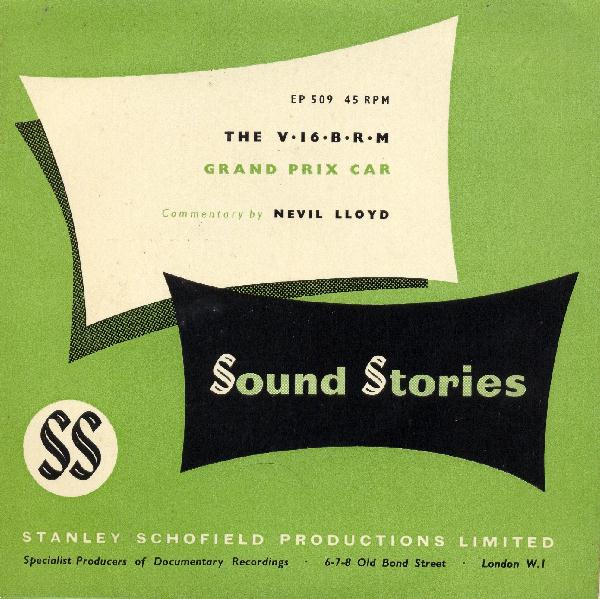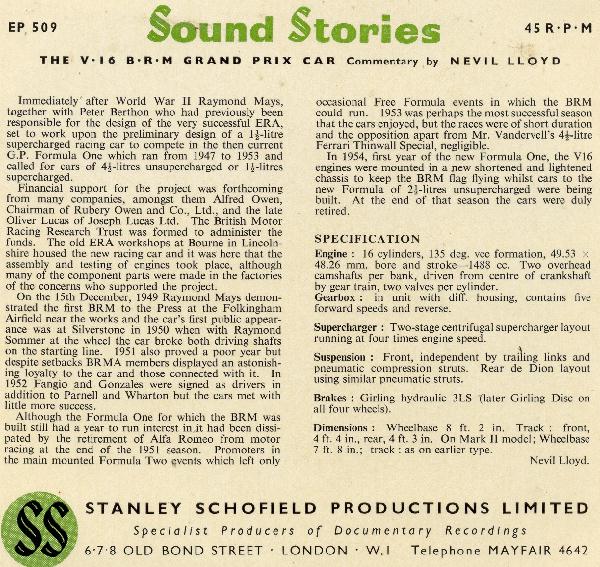|
BRM historic recording - 1955

|
The commentary for the recording was written
and narrated by Nevil Lloyd, interspersed with sounds of the BRM on
a test drive at Folkingham airfield and actuality from the Aintree
circuit race in October 1954. |
No grand prix car in motor racing history has
caused more controversy than has the V16 BRM. Conceived in 1947 by Raymond
Mays and Peter Berthon, the V16 was designed to compete under the Formula
I rules in existence from 1947 to 1953 which limited engine capacity to 4˝
litres unsupercharged or 1˝ litres with supercharger.
Not until two years later, in December 1949, was the first car
demonstrated at Folkingham airfield near the BRM works at Bourne in
Lincolnshire.
In 1950, the BRM won two short distance events and in 1951, their sole
success with fifth and seventh in the British Grand Prix at Silverstone
against the forces of Ferrari and Alfa Romeo. It was feared that the very
advanced and complicated design of the car needed far greater resources
than those available and it was an irony of fate that their comparative
success in the 1951 British Grand Prix was obtained in the very race that
was to mark the end of the supremacy of the 1˝ litre supercharged engine
over the unknown 4˝ litre. When Gonzales on the big Ferrari defeated his
compatriot Fangio on Alfa Romeo, he withdrew from racing at the season’s
end.
Promoters in 1952 turned to Formula grouping and few races were run in
which the BRM was eligible to compete. Nevertheless, the V16 gained a one,
two, three win at Goodwood in September to end the 1952 season upon a note
as triumphant as that of the car itself.
This success came too late and soon afterwards the BRM project passed into
the hands of Alfred Owen, one of the original supporters of the trust. Few
Formula I events were run in 1953, for a new Formula I was due to start in
1954, but in three Formula events, the V16 gained six wins, five seconds
and three thirds, and their running battle with Tony Vandervell’s 4˝ litre
Ferrari Thinwall Special throughout the season made it a most exciting
one.
1954 saw the V16 engines mounted in a shortened and lightened chassis
known as the Type 15 Mark II. Four victories were scored in as many races
in the early part of the season to encourage the loyal supporters whose
faith in the marque had never wavered.
The Mark II BRM made its final racing appearance at the Aintree circuit in
October 1954 when two cars competed in the 17-lap Free Formula event. The
front row of the grid consisted of the two BRMs, Moss on the new Formula I
Maserati and Collins on the Thinwall Special. There were 23 starters
awaiting the fall of the starter’s flag and above the thunderous roar of
racing engines could be heard the distinctive note of the V16.
But once more, and for the last time, the BRM flattered only the distance
and with one car out, the other could only finish third to the Maseratis.
The V16 BRM had run its final race. So ended a gallant but unavailing
effort to challenge the Italian Ferrari and Alfa Romeo, the two marques
which dominated the grand prix scene in the immediate post war years.
Nevertheless, the V16 BRM has its place in motor racing history for the
engine produced more horse power than any orthodox engine yet built. Nor
can one forget the faith of the men behind it, or the skill and the
courage of those that drove it, Moss, Fangio, Gonzales, Wharton, Parnell,
Flockhart and many others. Unforgettable too, was the sound of the V16 in
full song.

Return to Raymond Mays

Go to:
Main Index Villages
Index
|

